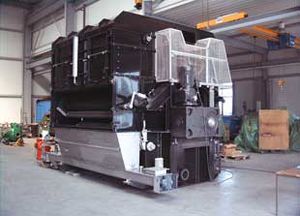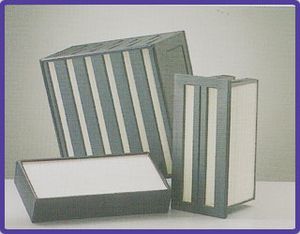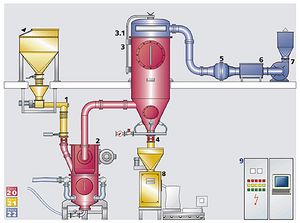Difference between revisions of "ATEX Filters"
(Created page with "Category:Filtration{{Knoppen}} <noinclude><!------------------------------------------------ * READ THIS FIRST * Only edit this page if you can improve the content. * Improp...") |
|||
| (8 intermediate revisions by 2 users not shown) | |||
| Line 1: | Line 1: | ||
[[Category:Filtration]]{{Knoppen}} | [[Category:Filtration]]{{Knoppen}} | ||
[[File:ATEX_Filter01.jpg|thumb|right|ATEX filter]] | |||
* | [[File:ATEX_Filter02.jpg|thumb|right|ATEX component]] | ||
* | [[File:ATEX_Filter03.jpg|thumb|right|ATEX processing system]] | ||
* | An '''ATEX Filter''' is a device that separates two or more media and complies with an explosion standard. The ATEX directive consists of two European Union (EU) directives describing what equipment and work environment is allowed in an environment with an explosive atmosphere. ATEX derives its name from the French title of the 94/9/EC directive: Appareils destinés à être utilisés en ATmosphères EXplosives. | ||
* | |||
* | |||
* ---- | ==ATEX Directive== | ||
Statistics show that [[filters]] are involved in the second highest percentage of dust explosions that occur in industrial applications including pharmaceutical, chemicals, metal, food, plastics, coal and wood. In July 2003, the new ATEX Directive 94/9/EC (ATEX 95) was implemented Europe-wide to eliminate the possibility of explosions related to equipment used in potentially explosive gaseous or dusty environments. | |||
==Filter Housing== | |||
Filter housing parameters constructed of conductive materials- | |||
Grounding terminals on housing | |||
Conductive o-rings and gaskets | |||
==Testing and Documentation== | |||
Each filter assembly and filter element is individually tested for conductivity | |||
* A point to point resistance test is performed | |||
* Filter housings are approved at 1000 ohms or less | |||
* In process inspections and a final inspection is performed | |||
* Each filter is assigned a serial number for easy traceability documentation is recorded and is available upon request. | |||
==Applications and Equipment== | |||
* Ash Handling | |||
* Plastic Industry | |||
* Chemical Processing | |||
* Pneumatic Conveying Systems | |||
* Industrial Aerosol Scrubbing | |||
* Vacuum Metallizing | |||
* Woodworking | |||
* Coal Industry | |||
* Pharmaceutical Industry | |||
* Food Industries | |||
* [[Vacuum Pumps]] & Systems | |||
* Blowers - Side Channel & Roots | |||
==Features and Specifications== | |||
* ATEX certified housing construction | |||
* All housings have an electrical conductive path between grounding terminal and housing cover | |||
* All gaskets and o-rings are electrically conductive | |||
* All filter elements have been designed and constructed to be electrically conductive | |||
* Durable zinc plated carbon steel housings | |||
* Heavy duty T bolts or industrial strength v-band for easy maintenance | |||
* Positive engagement o-ring seal system | |||
* Inlet/outlet 1/4” taps for gauges | |||
* Temp (continuous):min –15°F max 220°F | |||
==Video== | |||
<youtube>2cDZAhrqEIo</youtube> | |||
Latest revision as of 00:52, 18 February 2013
An ATEX Filter is a device that separates two or more media and complies with an explosion standard. The ATEX directive consists of two European Union (EU) directives describing what equipment and work environment is allowed in an environment with an explosive atmosphere. ATEX derives its name from the French title of the 94/9/EC directive: Appareils destinés à être utilisés en ATmosphères EXplosives.
ATEX Directive
Statistics show that filters are involved in the second highest percentage of dust explosions that occur in industrial applications including pharmaceutical, chemicals, metal, food, plastics, coal and wood. In July 2003, the new ATEX Directive 94/9/EC (ATEX 95) was implemented Europe-wide to eliminate the possibility of explosions related to equipment used in potentially explosive gaseous or dusty environments.
Filter Housing
Filter housing parameters constructed of conductive materials- Grounding terminals on housing Conductive o-rings and gaskets
Testing and Documentation
Each filter assembly and filter element is individually tested for conductivity
- A point to point resistance test is performed
- Filter housings are approved at 1000 ohms or less
- In process inspections and a final inspection is performed
- Each filter is assigned a serial number for easy traceability documentation is recorded and is available upon request.
Applications and Equipment
- Ash Handling
- Plastic Industry
- Chemical Processing
- Pneumatic Conveying Systems
- Industrial Aerosol Scrubbing
- Vacuum Metallizing
- Woodworking
- Coal Industry
- Pharmaceutical Industry
- Food Industries
- Vacuum Pumps & Systems
- Blowers - Side Channel & Roots
Features and Specifications
- ATEX certified housing construction
- All housings have an electrical conductive path between grounding terminal and housing cover
- All gaskets and o-rings are electrically conductive
- All filter elements have been designed and constructed to be electrically conductive
- Durable zinc plated carbon steel housings
- Heavy duty T bolts or industrial strength v-band for easy maintenance
- Positive engagement o-ring seal system
- Inlet/outlet 1/4” taps for gauges
- Temp (continuous):min –15°F max 220°F
Video


